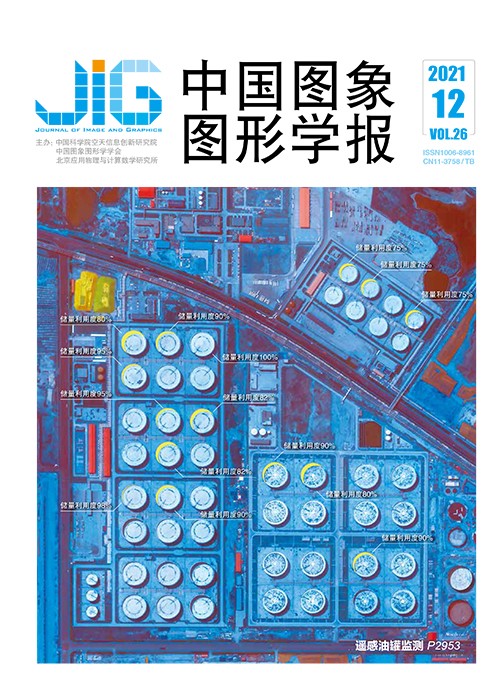
联合分块谱带优选和深度特征的高光谱人脸识别
摘 要
目的 高光谱人脸数据具有丰富的鉴别信息。最优谱带选择和谱内间特征表示是高光谱人脸识别的关键。基于高光谱波段范围为4001 090 nm和采样间隔为10 nm的高光谱成像人脸数据,本文提出一种分块谱带选择和VGG(Visual Geometry Group)网络的高光谱人脸识别方法。方法 为了优化适合人脸识别的谱带组合,基于人脸关键点,提出分块局部二值模式(local binary pattern,LBP)特征的AdaBoost支持向量机(support vector machine,SVM)谱带选择方法。基于卷积神经网络结构建立一个面向高光谱人脸特点的深度网络(VGG12),提取谱带内特征。融合不同谱带的深度特征,利用三层堆栈自编码器(stack auto-encoder,SAE)抽取谱间特征。对提取的谱间和谱内特征,采用最近邻分类器完成最后的识别。结果 为了验证提出方法的有效性,在公开的高光谱人脸数据集UWA-HSFD(University of Western Australia hyperspectral face database)和PolyU-HSFD(Hong Kong Polytechnic University hyperspectral face database)上进行对比试验。结果显示,基于分块LBP特征的谱带选择算法优于传统基于整幅图像像素的方法,提出的VGG12网络相比已有深度学习网络,仅保留少量(68个)谱带,在两个数据集上都取得了最高的识别率(96.8%和97.2%),表明传统可见光人脸深度网络并不适合高光谱人脸识别。结论 实验结果表明,高光谱数据用于人脸识别中,谱带选择与深度学习结合是有效的,本文方法联合有监督深度网络(VGG12)和无监督学习网络(SAE)挖掘谱内和谱间鉴别特征,在降低深度网络训练复杂度的同时取得了较其他深度网络更好的识别性能。
关键词
Hyperspectral face recognition based on partition bands optimal selection and deep features
Xie Zhihua, Li Yi, Niu Jieyi(Key Laboratory of Optic-Electronic and Communication, Jiangxi Sciences and Technology Normal University, Nanchang 330031, China) Abstract
Objective The applications of hyperspectral face imaging have been getting more and more concerned due to the low cost of hyperspectral camera. Hyperspectral imaging has been providing sufficient distinctive information along the spectral dimension for unconstrainted face recognition system. The hyperspectral face images have been taking challenges such as low signal to noise ratio, high computational complexity and cross-band misalignment. High data dimensionality can result in high computational costs. Not all spectral bands are equally informative and discriminative. The useless spectral band usage may even produce noises and weaken the performance. Spatial feature extraction and optimal bands selection have been two vital issues for robust hyperspectral face recognition. The feature representation based on deep learning has obtained excellent performance in image classification tasks. The deep neural networks to extract spatial features for hyperspectral face data have been focused on. A novel hyperspectral face recognition method based on automatic bands selection and visual geometry group network (VGG net) with the success of VGG net in traditional face recognition. Method First, an improved AdaBoost algorithm has been built up to select the optimal bands for different facial regions. One face has been divided into 3×5 partition mode based on the robust 68 landmarks from the cascade regression method to get the adaptive spectral features for different facial organs. Next, support vector machine (SVM) has been opted as a weak classifier for AdaBoost ensemble learning for bands selection. SVM is more suitable for small sample and high dimension sets, and lower sensitivity to imbalanced datasets, which are the characteristics of hyperspectral face data. Thus, the AdaBoost SVM algorithm has been used to select optimal bands (ranging from 450 nm to 1 090 nm) for hyperspectral face recognition. The AdaBoost SVM is based on partition local binary pattern (LBP) features. Second, a convolutional neural network (CNN) structure has been built for deep feature extraction in each hyperspectral face image based on VGG12 deep network. Therefore, VGG12 network can fulfill the deep feature extraction in spatial domain. Third, a three-layer stacked auto-encoder (SAE) has been trained to mine the discriminative and compact features amongst different bands. Finally, the nearest neighbor classifier has been applied to get the final results. The automatic bands selection is based on partition LBP features instead of original images. The optimal bands selection can choose the most suitable bands for different regions in faces. The second novelty has combined the supervised deep network (VGG12) with unsupervised learning network (SAE) to fully mine within and between spectral features in hyperspectral faces. Result To verify the effectiveness of the proposed hyperspectral face recognition method, the comparative experiments have been conducted on public UWA hyperspectral face database (UWA-HSFD) and Hong Kong Polytechnic University hyperspectral face database (PolyU-HSFD) databases where the spectral bands vary from 400 to 1 090 nm with the spectral interval of 10 nm. The two datasets have been preprocessed and normalized to 220×180 hyperspectral face images. The ratio of the test set of the training set is 1:1. The first half samples have been used as the training set and the rest have been used as the test set. The VGG12 network has been trained based on the multi-spectral bands cycle. The objective function of the network is Adam. The super parameters of VGG12 are set as follows:α=0.001, β1=0.9, β2=0.999, epoch=10. The learning rate of SAE network is 0.000 1 and epoch is 10. The all experiments have been implemented on the computer platform whose configuration is of 2.6 GHz CPU, 8 GB GPU. In contrast experiment 1, the bands selection algorithm based on partition LBP features has been superior to the traditional method based on the whole faces. The main reason is that partition LBP features can improve the influence of non-alignment factors of hyperspectral facial data and select optimal bands combination for the different face regions. In contrast experiments 2, the method with SAE model can get a higher recognition rate than that without SAE model by introducing little computational complexity (about 15% consuming time). In contrast experiment 3, compared with the existing deep learning network, the proposed VGG12 network, retaining only 68 spectral bands, achieves the highest recognition rates (96.8% and 97.2%) on both databases. Conclusion The experiment results have shown that the combination of bands selection and VGG12 is feasible and effective for the performance improvement of hyperspectral face recognition.
Keywords
|



 中国图象图形学报 │ 京ICP备05080539号-4 │ 本系统由
中国图象图形学报 │ 京ICP备05080539号-4 │ 本系统由